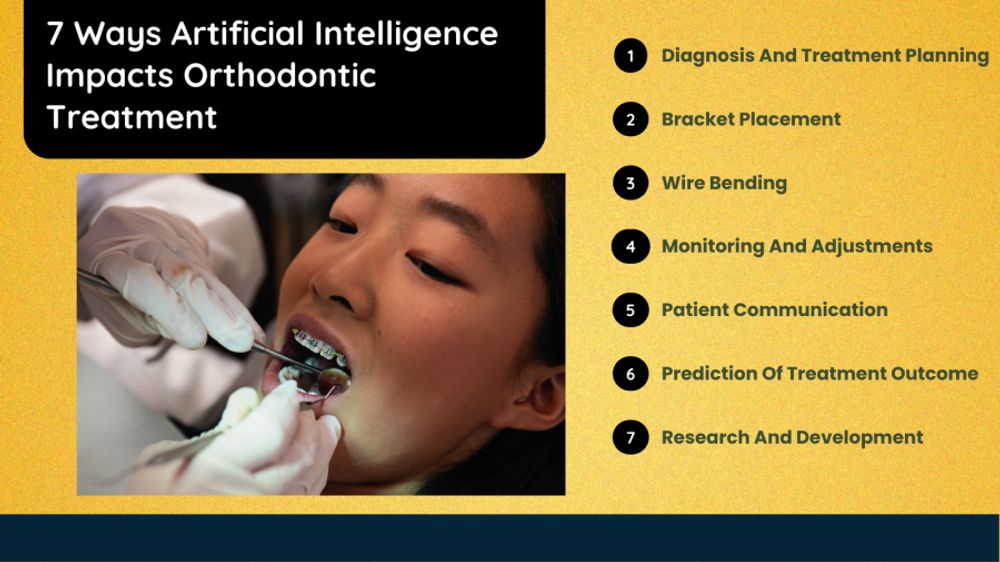

Orthodontics is a crucial field of dentistry that helps people achieve healthy and attractive smiles. Artificial intelligence (AI) has significantly revolutionized orthodontic treatment in recent years.
With its capacity to analyze large volumes of data and learn from past experiences, AI has opened up new possibilities for diagnosing, treating, and monitoring patients. From diagnosis and treatment planning to patient communication and outcome prediction, AI can transform every aspect of orthodontic treatment, allowing organizations to take advantage of the orthodontist email list.
This article will explore 7 ways AI impacts orthodontic treatment, highlighting the ethical considerations of using AI in orthodontic treatment.

AI-assisted diagnosis and treatment planning in orthodontics is a relatively new field of technology that is gaining attention in the dental world. It involves using Artificial Intelligence (AI) to assist orthodontists in diagnosing, monitoring, and treatment planning the care of their patients.
It can help improve patient outcomes and reduce patient visits by providing orthodontists with a more precise and accurate diagnosis of a patient's condition.
Examples:
Smart software uses machine learning algorithms to analyze dental images, identify specific problems, and provide treatment recommendations. For instance, one such AI tool, OrthoScreen, can analyze radiographs to identify abnormalities and suggest treatment options.
Virtual treatment planning software creates 3D models of a patient's mouth, allowing orthodontists to plan and simulate treatment options. AI-powered software like SureSmile and Invisalign uses AI algorithms to design customized treatment plans for each patient.
Bracket Placement
AI-assisted bracket placement in orthodontics revolutionizes how orthodontic treatment is delivered to patients. It is a process that combines artificial intelligence, dental imaging, and 3D facial scanning technology to identify, assess, and place brackets on the patient's teeth accurately.
This technology can be used to check the accuracy of bracket placements and to identify and suggest the best placement for each patient based on their facial features.
Examples:
Bracket positioning software uses AI to analyze dental images and suggest optimal bracket placement. One such tool is BracketEars, which can identify the ideal position for each bracket based on factors like tooth anatomy, malocclusion severity, and other patient-specific factors.
AI-powered robots can assist orthodontists with bracket placement by accurately positioning brackets on each tooth. The SmartBracket system uses AI algorithms to place brackets automatically, reducing treatment time and improving accuracy.
Wire Bending
Artificial intelligence (AI) is becoming important in orthodontics, particularly for wire bending. It enables orthodontists to take a much more precise approach to wire bending than ever, allowing for more accurate and efficient treatment.
The AI system can calculate the best possible path for the wire and even recommend which bends a user should make to achieve the desired shape. It can be extremely helpful for orthodontists, as it can take the guesswork out of wire bending and make it easier to achieve the desired outcome.
Examples:
AI-powered wire-bending machines use machine learning algorithms to create customized wires. For instance, the OrthoForm wire bending system uses AI to create wires specific to each patient's unique treatment plan.
AI algorithms are employed to make custom-fit wires for 3D-printed orthodontic appliances, tailored to each patient's teeth. One such tool is the OrthoForm Archwire, which uses AI to create archwires tailored to each patient's needs.
Monitoring And Adjustments
Artificial intelligence is increasingly being used to monitor and adjust orthodontics in the modern era. As technology grows, so does the ability to use AI to monitor and adjust the progress of orthodontic treatments.
Artificial intelligence can be used to spot minor changes in teeth and jaw structure, predict the effects of treatments, and make modifications when necessary.
Examples:
AI-enabled software examines treatment growth and proposes adjustments to treatment plans. OrthoTrac's AI system can analyze patient data and provide insights to orthodontists, enabling them to make data-driven decisions about treatment adjustments.
